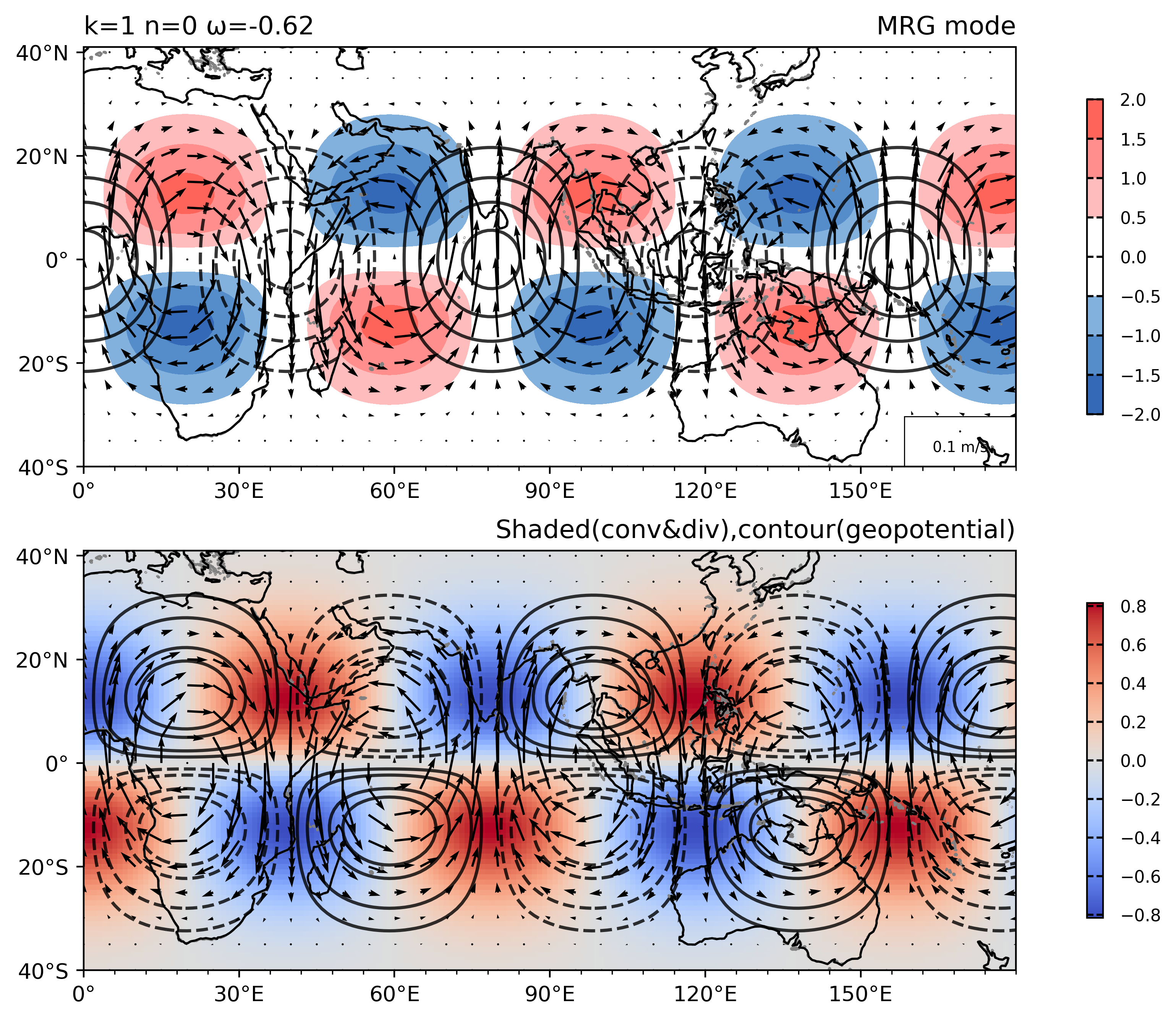
赤道地区的波动现象最早可以追述到20世纪40年代,Dunn(1940)在分析大西洋上空逐日天气图的时候,注意到气压场具有逐日交替变化的波动现象,并且能够引起大西洋上空飓风的形成。这些波动起源于非洲北部,与中纬度的天气尺度波动具有不同的特征。在太平洋对流层的东风气流中同样存在类似的波动,同样可以在太平洋上空引发台风的生成。
理论研究逐渐揭示了在一个旋转的星球上,在低纬度地区会存在被限制在赤道附近沿纬向传播的波动。Matsuno(1966)发表了他关于赤道波动的开创性论文:他使用赤道β平面上的浅水波方程组,得到了赤道附近沿着纬向传播波动的完整的解,它们包括赤道罗斯贝(ER)波、混合Rossby重力(MRG)波、开尔文(Kelvin)波、西传和东传重力惯性波。理论得到的MRG波波长大约9000km左右,环流中心位于赤道,具有南北反对称的风场结构,辐合辐散分别位于经向风场的出流和入流区域,沿着赤道向西或者向东传播。MRG波的存在很快就得到了证实。Yanai and Maruyama (1966) 和Maruyama (1967) 使用探空资料发现在太平洋上空平流层的低层存在西传MRG波的活动。而对流层中的MRG波也很快被发现(Zangvil 1975, Zangvil and Yanai 1980, 1981)。这些波动所观测到的移速、结构等特征,与Matsuno(1966)的理论结果十分吻合。之后的研究发现,在西太平洋,MRG波会在基本流的作用下逐渐转变成为热带低压(TD)型波动,引起台风的生成(Takayabu and Nitta 1993; Dinkinson and Molinari 2002)
随着卫星观测的发展和三维再分析资料的出现,MRG波的活动与热带深对流的活动的联系被逐渐揭示。Liebmann and Hendon (1990)使用ECMWF的三维分析场资料和卫星观测资料研究了太平洋MRG波,发现对流加强和对流抑制的位置正好位于对流层低层的辐合与辐散区。Dunkerton (1993) 使用1973年-1992年之间赤道附近的高空探测资料,发现了对流活动的变化与径向风有很好的关系,指出MRG波的环流与热带深对流之间的存在着耦合关系。Takayabu(1994)对热带太平洋的卫星红外观测资料进行了时空谱分析,发现热带对流活动的时空谱分布特征与Matusno(1966)的波动模态非常吻合,表明在太平洋上空,不仅MRG波中存在这种对流-环流耦合的关系,所有赤道波动模态与热带的对流活动之间都存在紧密的联系。Wheeler and Kiladis(1999)对全球的热带对流活动进行了类似的时空谱分析,他们同样发现谱的峰值分布与Matsuno(1966)浅水波方程解的频散曲线吻合的非常好,这进一步揭示了全球的热带对流活动与赤道波动模态之间的耦合关系。但是,Wheeler and Kiladis (1999) 指出,这些对流耦合波动的相速度比Matusno (1966)的理论速度慢,并且垂直结构也随着高度的上升有明显的倾斜(e.g. Liebmann and Hendon 1990; Takayabu and Nitta; 1993)。这显示了这些伴随着对流活动的波动的特征与性质与自由大气中的波动有着重要的区别。因此,为了区别这些伴随着对流活动的波动与自由大气中的波动,将前者称为“对流耦合赤道波动”(convectively coupled equatorial wave),而将后者称之为赤道大气自由波动。
Reference
Dunn, G. E. 1940: Cyclogenesis in the tropical Atlantic, Bull. Am. Meteorol. Soc., 21, 215–229
Matsuno, T. 1966: Quasi-geostrophic motions in the equatorial area, J. Meteorol. Soc. Jpn., 44, 25–43.
Yanai, M., and T. Maruyama 1966: Stratospheric wave disturbances propagating over the equatorial Pacific, J. Meteorol. Soc. Jpn., 44, 291–294.
Maruyama, T. 1967: Large-scale disturbances in the equatorial lower stratosphere, J. Meteorol. Soc. Jpn., 45, 196–199.
Zangvil, A. 1975: Temporal and spatial behavior of large-scale disturbances in tropical cloudiness deduced from satellite bright- ness data, Mon. Weather Rev., 103, 904 – 920
Zangvil, A., and M. Yanai 1980: Upper tropospheric waves in the tropics. Part I: Dynamical analysis in the wavenumber-frequency domain, J. Atmos. Sci., 37, 283 – 298
Zangvil, A., and M. Yanai 1981: Upper tropospheric waves in the tropics. Part II: Association with clouds in the wavenumber-frequency domain, J. Atmos. Sci., 38, 939–953
Takayabu, Y. N., and T. S. Nitta. 1993: 3–5 day-period disturbances coupled with convection over the tropical Pacific Ocean, J. Meteorol. Soc. Jpn., 71, 221–246.
Dickinson, M., and J. Molinari, 2002: Mixed Rossby–gravity waves and western Pacific tropical cyclogenesis. Part I: Synoptic evolution. Journal of the Atmospheric Sciences, 59, 2183-2196
Liebmann, B., and H. H. Hendon. 1990: Synoptic-scale disturbances near the equator, J. Atmos. Sci., 47, 1463–1479
Dunkerton, T. J., 1993: Observation of 3–6-Day Meridional Wind Oscillations over the Tropical Pacific, 1973–1992: Vertical Structure and Interannual Variability. Journal of the Atmospheric Sciences, 50, 3292-3307
Takayabu, Y. N. 1994: Large-scale cloud disturbances associated with equatorial waves. Part I: Spectral features of the cloud disturbances, J. Meteorol. Soc. Jpn., 72, 433–448.
Wheeler, M., and G. N. Kiladis, 1999: Convectively coupled equatorial waves: Analysis of clouds and temperature in the wavenumber–frequency domain. Journal of the Atmospheric Sciences, 56, 374-399